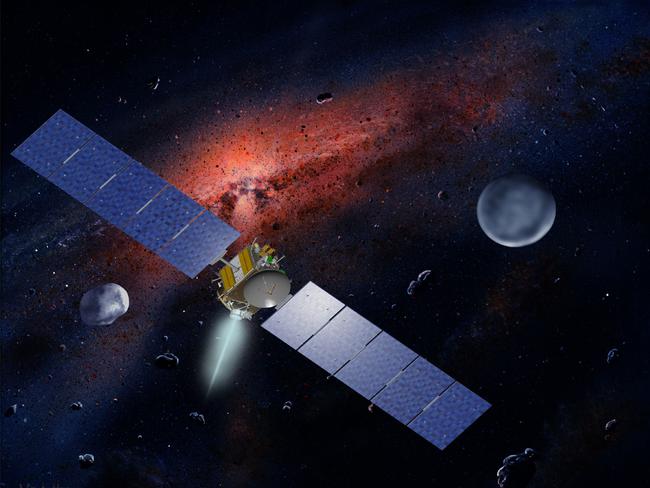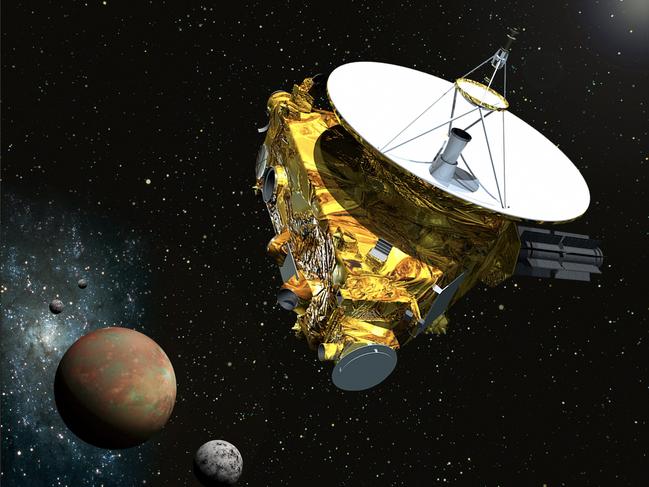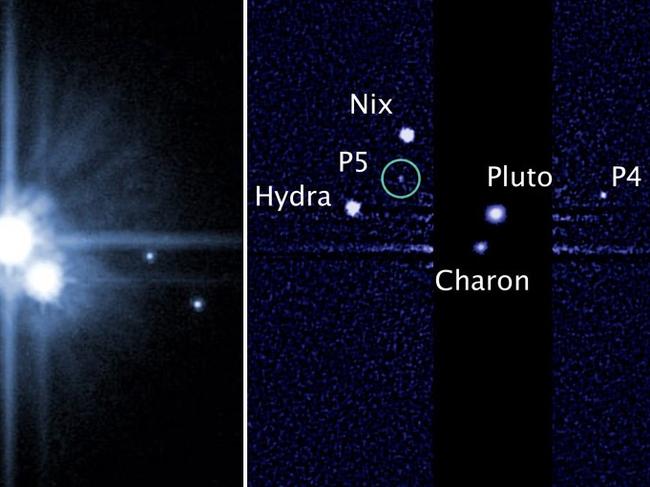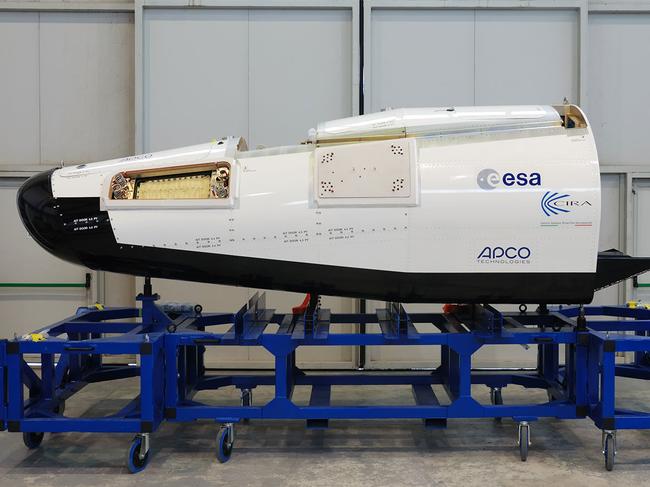TWO space probes will take us into our solar system’s darkest corners this year, and they’re already giving us amazing glimpses of what is to come.
Space exploration is ramping up: 2014 was the year we landed on a comet and found a host of new worlds orbiting distant suns.
This year will be bigger: We get to see some of the most unusual objects in our Solar System for the first time — the dwarf planets Pluto and Ceres.
Like all the cool kids, these robotic probes — and their human handlers — are broadcasting each and every step of their grand tour billions of kilometres into deep space, on Twitter.
#Ceres from the spacecraft [moi!] yesterday, 147K km away in all its planetary mystery: http://t.co/PaHIEcPlM4 pic.twitter.com/NKsu0GqUO7
— NASA's Dawn Mission (@NASA_Dawn) January 27, 2015Pluto - about 4.8 billion kilometres from Earth - is the one we all know as the former ninth planet. Under its old title, this icy lump of something would be the only one we’ve not yet sent a probe to.
Ceres may be the mysterious heart of a failed planet: It sits prominently among a band of rubble between Mars and Jupiter that never “congealed” while the rest of our worlds were forming.
Now the first, tantalising, happy snaps of both worlds are in.
Astrophysicist Dr Alan Duffy of Swinburne University says space probes often end up generating more questions than they were initially sent out to solve. This pair are already living up to that expectation.
2015 is a busy year w 2 spacecraft exploring dwarf planets #Ceres & #Pluto at opposite ends of the Solar System to learn how planets form
— Alan Duffy (@astroduff) January 30, 2015According to Dawn’s Twitter account , it’s had the most interesting trip so far: It was launched back in 2007 and has already visited one asteroid — Vesta, in 2011.
So why the interest in Ceres, a name not usually high on the astronomy reading lists? Because it may possibly contain liquid water beneath an icy crust — an ideal condition for life. Perhaps that has something to do with a mysterious bright-white spot captured in the probe’s first photos.
New Horizons has had a much harder slog: Almost five billion kilometres and nine years in fact. It woke up from hibernation to prepare for its visit in December. It’s now turning its eyes towards the rapidly approaching bright dot that is mysterious Pluto. It will swing past on a one-way trip into infinity in July, grabbing as much information as it can.
COOLU! The 7 wonders of space exploration: http://t.co/o1jxCzERO4 pic.twitter.com/7ErwUAWba2
— NewHorizons2015 (@NewHorizons2015) January 28, 2015While these two probes are the headline acts, there is still plenty of science happening elsewhere in the solar system and directly above our heads.
The Rosetta mission about comet 67P/Churyumov-Gerasimenko is still active. In fact, it’s going to join the comet in its dive on the Sun. There is yet hope that its lost lander, Philae, can be reactivated once the crater it toppled into is exposed to light.
And then there are the first launches of several private space “taxis” that may yet lead the way to a return to the Moon or maybe beyond — a manned mission to Mars.
Oh, and by the way: Hubble’s 25th birthday is bound to be a doozy.

CERES: DAWN
It arrives at the biggest object in our solar system’s asteroid belt on March 6, but space probe Dawn has already had an encounter with another intriguing heavenly body — Vesta. (It has a nifty new ion engine allowing it to manoeuvre more than previous space probes.)
“Vesta was a stunning surprise, with a giant hole missing from the southern half of the dwarf planet. If we scaled Vesta up to Earth then this hole would be the size of the Pacific Ocean,” Dr Duffy says. “It’s estimated that five per cent of all the meteorites that have made it to Earth have come from this single collision.”
Dawn’s latest snapshots are provoking a similar degree of head-scratching.
There’s a strange white blob on the planetoid’s surface.
“That’s getting everyone excited, even though we only have to wait another month or so to find out what it is,” Dr Duffy says.
Ceres is a body that actually benefited from the reclassification that stripped Pluto of its “planet” status. It’s now defined as a “dwarf planet”, which suits because — unlike asteroids — it’s big enough for its gravity to have pulled the dust, ice and gas into a sphere.
It is believed to be about 25 per cent water — some of which astronomers hope will be in liquid form.
Coming soon, @mdk02026, and you can also #ImagineCeres yourself! http://t.co/FyXXhtoIBQ pic.twitter.com/bJ7m6QOjpj
— NASA's Dawn Mission (@NASA_Dawn) January 29, 2015There are hints this may be so: The Herschel space telescope last year found a water vapour cloud around Ceres. Some suggest this may have come from erupting plumes like those found on Saturn’s moon Enceladus. Others say the dwarf planet may even have its own rivers and oceans.
“Ceres looks like a fully formed planet having a permanent ice age,” Dr Duffy says. “With Ceres something has stopped the baby planet from growing any further.”
Only Dawn can tell us.

PLUTO: NEW HORIZONS
This epic journey began in January 2006 when an Atlas V rocket blasted off from Cape Canaveral in Florida and hauled the piano-sized New Horizons craft off Earth.
It began snapping photos of the pale dot which is Pluto — still 130 million miles ahead of it — late last year. But soon these will be among the clearest, most detailed images we’ve ever seen.
They’re due to start arriving any day now.
The best is clearly yet to come — probably about July 14 which is when the probe passes at its closest point. The whole encounter is expected to last about six months.
We're on approach to Pluto! Good data is coming to Earth from 4 instruments--SWAP, PEPSSI, SDC & LORRI. Mission ops & eng teams r reviewing.
— NewHorizons2015 (@NewHorizons2015) January 29, 2015
“It will race by at 14.6 kilometres per second, over 50,000km/h, meaning it only has a few days to perform the critical science with detailed scans on the dwarf planet before plunging by,” Dr Duffy says. “The craft is so far away, and the signal sending the data back so weak, that it could then take months to transmit these phenomenal images back to Earth.”
Pluto is about 2300 kilometres in diameter, smaller than Earth’s moon.
COOL FACT I just learned: The solar wind that SWAP will measure at Pluto in July passes the Earth NEXT WEEK on its way to Pluto in July!
— NewHorizons2015 (@NewHorizons2015) January 27, 2015“We don’t know what we’ll find … but that’s why it’s so exciting. There could be erupting geysers, planetary rings around Pluto, strange orbits with the moons around it and even the atmosphere might freeze back to ‘snow’ as Pluto drifts further out from the Sun. “
After New Horizons flashes past Pluto, it will begin another immensely long journey to take it past other objects in the Kuiper Belt — a vast ring of debris left over from the solar system’s birth some 4.6 billion years ago.
RACE OF THE SPACE TAXIS
The boffins are kicking the tyres and slamming the doors on a range of potential new space taxies to get us humans up into orbit — and beyond.
SpaceX got the year off to a bad start when it attempted to land a reusable rocket on a floating launch pad. It was yet another crash-land-burn — but it did come close to success.
But nothing worthwhile is ever easy.

The European Space Agency is hoping that disasters come in groups of threes. As three have already happened (Cygnus, Virgin Galactic and SpaceX — all of which are expected to continue testing this year), the agency is no doubt hoping the die-roll is due to come up with a winner. It’s due to launch a test flight of its reusable, shoe-shaped Intermediate Experimental Vehicle (IXV) in February. Essentially, it’s a robotic mini shuttle intended to carry stuff back and forth from the International Space Station.
Also expected is flight testing of the competitor to Virgin Galactic’s Galaxy space-plane: XCOR Aerospace’s Lynx. This plane is intended to take passengers as commercial customers, as well as science experiments, to the edge of space.
Lurking quietly behind these private ventures is the US military’s ultra-secret X-37B robotic space plane. It is scheduled for its fourth launch in May. Some of its mysterious past flights have lasted more than a year. Some day, in the not-to-near future, we may learn exactly what these little shuttle-like craft are actually up to.

Add your comment to this story
To join the conversation, please log in. Don't have an account? Register
Join the conversation, you are commenting as Logout
Here’s what you can expect with tomorrow’s Parramatta weather
As winter sets in what can locals expect tomorrow? We have the latest word from the Weather Bureau.
Here’s what you can expect with tomorrow’s Parramatta weather
As winter sets in what can locals expect tomorrow? We have the latest word from the Weather Bureau.